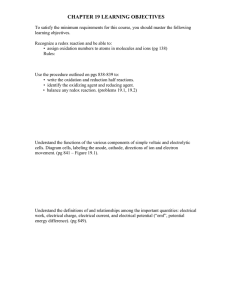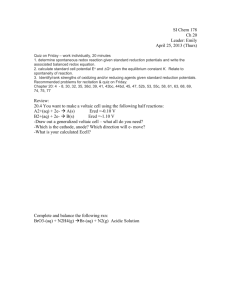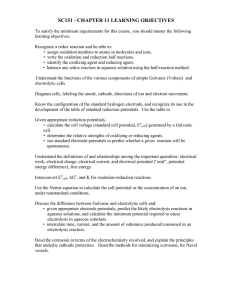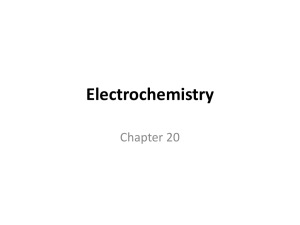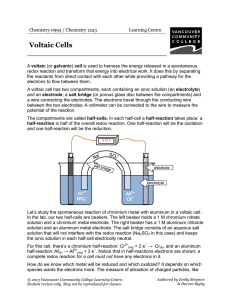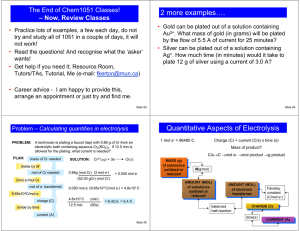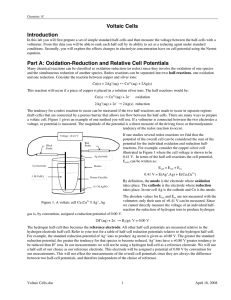Followings are what you will find at the end of... For LEARNING OBJECTIVES: Highlight the main idea for EACH...
advertisement
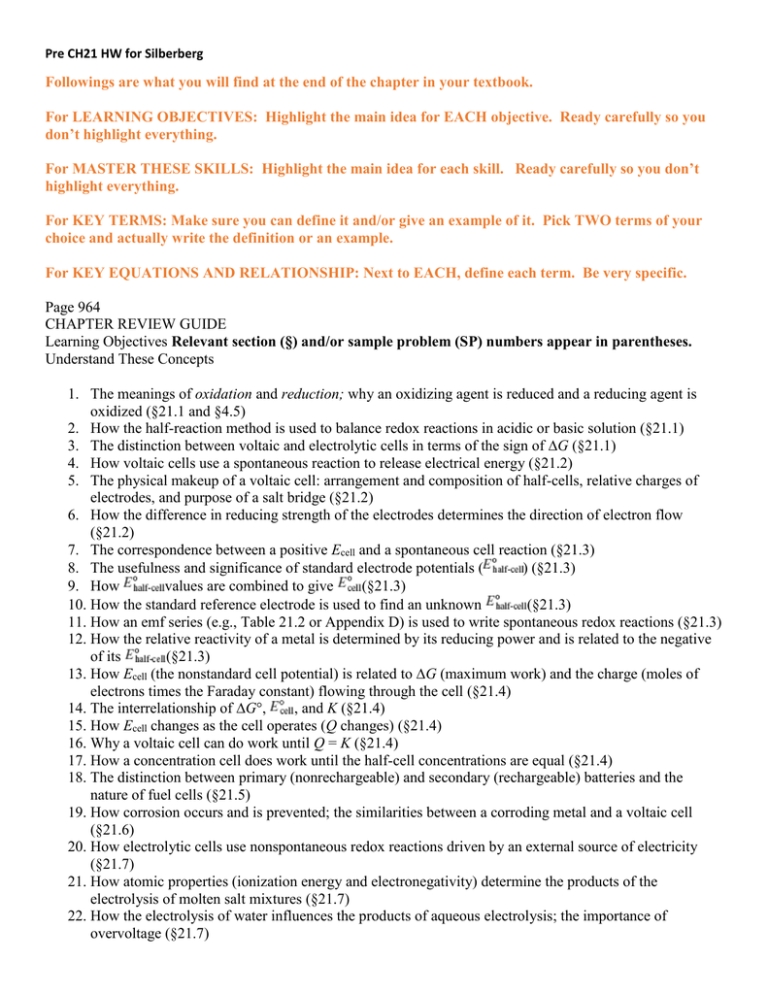
Pre CH21 HW for Silberberg Followings are what you will find at the end of the chapter in your textbook. For LEARNING OBJECTIVES: Highlight the main idea for EACH objective. Ready carefully so you don’t highlight everything. For MASTER THESE SKILLS: Highlight the main idea for each skill. Ready carefully so you don’t highlight everything. For KEY TERMS: Make sure you can define it and/or give an example of it. Pick TWO terms of your choice and actually write the definition or an example. For KEY EQUATIONS AND RELATIONSHIP: Next to EACH, define each term. Be very specific. Page 964 CHAPTER REVIEW GUIDE Learning Objectives Relevant section (§) and/or sample problem (SP) numbers appear in parentheses. Understand These Concepts 1. The meanings of oxidation and reduction; why an oxidizing agent is reduced and a reducing agent is oxidized (§21.1 and §4.5) 2. How the half-reaction method is used to balance redox reactions in acidic or basic solution (§21.1) 3. The distinction between voltaic and electrolytic cells in terms of the sign of ∆G (§21.1) 4. How voltaic cells use a spontaneous reaction to release electrical energy (§21.2) 5. The physical makeup of a voltaic cell: arrangement and composition of half-cells, relative charges of electrodes, and purpose of a salt bridge (§21.2) 6. How the difference in reducing strength of the electrodes determines the direction of electron flow (§21.2) 7. The correspondence between a positive Ecell and a spontaneous cell reaction (§21.3) 8. The usefulness and significance of standard electrode potentials ( ) (§21.3) 9. How values are combined to give (§21.3) 10. How the standard reference electrode is used to find an unknown (§21.3) 11. How an emf series (e.g., Table 21.2 or Appendix D) is used to write spontaneous redox reactions (§21.3) 12. How the relative reactivity of a metal is determined by its reducing power and is related to the negative of its (§21.3) 13. How Ecell (the nonstandard cell potential) is related to ∆G (maximum work) and the charge (moles of electrons times the Faraday constant) flowing through the cell (§21.4) 14. The interrelationship of ∆G°, , and K (§21.4) 15. How Ecell changes as the cell operates (Q changes) (§21.4) 16. Why a voltaic cell can do work until Q = K (§21.4) 17. How a concentration cell does work until the half-cell concentrations are equal (§21.4) 18. The distinction between primary (nonrechargeable) and secondary (rechargeable) batteries and the nature of fuel cells (§21.5) 19. How corrosion occurs and is prevented; the similarities between a corroding metal and a voltaic cell (§21.6) 20. How electrolytic cells use nonspontaneous redox reactions driven by an external source of electricity (§21.7) 21. How atomic properties (ionization energy and electronegativity) determine the products of the electrolysis of molten salt mixtures (§21.7) 22. How the electrolysis of water influences the products of aqueous electrolysis; the importance of overvoltage (§21.7) 23. The relationship between the quantity of charge flowing through the cell and the amount of product formed (§21.7) Master These Skills 1. 2. 3. 4. 5. 6. 7. 8. Balancing redox reactions by the half-reaction method (§21.1 and SP 21.1) Diagramming and notating a voltaic cell (§21.2 and SP 21.2) Combining values to obtain (§21.3 and SP 21.3) Using and a known to find an unknown (SP 21.4) Manipulating half-reactions to write a spontaneous redox reaction and calculate its (SP 21.5) Ranking the relative strengths of oxidizing and reducing agents in a redox reaction (SP 21.5) Predicting whether a metal can displace hydrogen or another metal from solution (§21.3) Using the interrelationship of ∆G°, , and K to calculate one of the three given the other two (§21.4 and SP 21.6) 9. Using the Nernst equation to calculate the nonstandard cell potential (Ecell) (SP 21.7) 10. Calculating Ecell of a concentration cell (SP 21.8) 11. Predicting the products of the electrolysis of a mixture of molten salts (SP 21.9) 12. Predicting the products of the electrolysis of aqueous salt solutions (SP 21.10) 13. Calculating the current (or time) needed to produce a given amount of product by electrolysis (SP 21.11) Key Terms Page numbers appear in parentheses. electrochemistry (919) electrochemical cell (919) Section 21.1 half-reaction method (920) voltaic (galvanic) cell (924) electrolytic cell (924) electrode (924) electrolyte (924) anode (924) cathode (924) Section 21.2 half-cell (926) salt bridge (927) Section 21.3 cell potential (Ecell) (930) voltage (930) electromotive force (emf) (930) volt (V) (930) coulomb (C) (930) standard cell potential ( ) (930) standard electrode (half-cell) potential ( ) (930) standard reference half-cell (standard hydrogen electrode) (931) Section 21.4 Faraday constant (F) (939) Nernst equation (941) concentration cell (944) Section 21.5 battery (947) fuel cell (950) Section 21.6 corrosion (951) Section 21.7 electrolysis (955) overvoltage (958) ampere(A) (959) Page 965 Key Equations and Relationships Page numbers appear in parentheses. 21.1 Relating the sponteneity of a process to the sign of the cell potential (930): 21.2 Relating electric potential to energy and charge in SI units (930): 21.3 Relating standard cell potential to standard electrode potentials in a voltaic cell (931): 21.4 Defining the Faraday constant (939): 21.5 Relating the free energy change to the cell potential (939): 21.6 Finding the standard free energy change from the standard cell potential (939): 21.7 Finding the equilibrium constant from the standard cell potential (940): 21.8 Substituting known values of R, F, and T into Equation 21.7 and converting to common logarithms (940): 21.9 Calculating the nonstandard cell potential (Nernst equation) (942): 21.10 Substituting known values of R, F, and T into the Nernst equation and converting to common logarithms (942): 21.11 Relating current to charge and time (959): Answer the following questions. Show your work. (a) Using your own words, explain what electronegativity measures. (b) Is electronegativity intensive or extensive? (c) Define Oxidation, Reduction, Oxidizing agent, Reducing agent. (d) Explain SHE, standard hydrogen electrode. (e) Using your own words, explain standard reduction potential. (f) Summarize 5 steps involved in Half-Reaction method for balancing redox. (g) Cr(s)/Cr+3(aq)//Ag+1(aq)/Ag(s) For this given shorthand cell notation, write the chemical equation showing what happens at anode, and at cathode. Then write the overall equation. (h) Look up a Galvanic Cell set up with Zn and Cu. Sketch it here. Identify cathode and anode. (i) Using Figure 21.10, redraw the triangle showing the relationship between G,E,and K.

